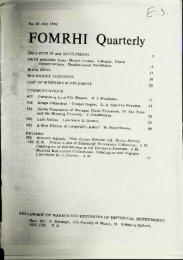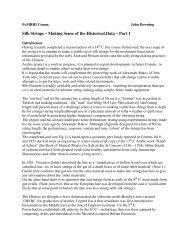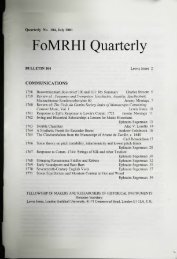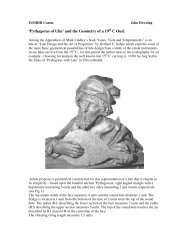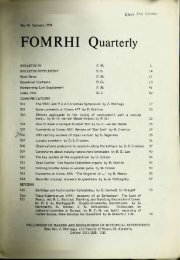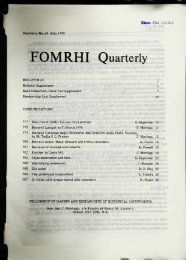•rf - FoMRHI
•rf - FoMRHI
•rf - FoMRHI
Create successful ePaper yourself
Turn your PDF publications into a flip-book with our unique Google optimized e-Paper software.
The styles of written music for the instruments diffcr considerably, the lyra viol<br />
music consisting of a mixture of chords, of sequential notes jumping up and down<br />
to give the impression of 2 or more separate parts and of divisions , while the<br />
Italian viola bastarda music mainly contains norid divisions on one part at a time.<br />
Of course we cannot be sure that the viola bastarda did not extempori2e chords and<br />
we cannot be sure that the lyra viol did not extempori ze more florid divisions. An<br />
example of more extended use of a viol than its written music indicates is Ganassi's<br />
(li) recommendations concerning bows^which include low hair-tension for playing<br />
chords, a style of playing not generally discussed in the 16th century.<br />
Another similarity is the size of these instruments, between that of the tenor and<br />
bass consort viols. Figure 3 compares string lengths given by Praetorius and the<br />
Talbot ms (e 1690). (i7)<br />
Figure 3. Comparison of strine lengths of vipls<br />
Praetorius<br />
Name<br />
Cant Viol de Gamba<br />
Tenor= Alt- Viol de Gamba<br />
Viol Bastarda<br />
Klein Bass -Viol de Gamba<br />
String<br />
Length<br />
41.2 cm<br />
58.6 cm<br />
73.0 cm<br />
75.6 cm<br />
Talbot<br />
Name<br />
Treble viol<br />
Tenor viol<br />
Lvra viol<br />
Bass Viol<br />
String<br />
Length<br />
40.6 cm<br />
61.0 cm<br />
71.4 cm<br />
81.3 cm<br />
These sizes have little rescmblance to those of viols played today. We shall be<br />
writing much more on this issue, but for now, suffice it to say that modem writers<br />
have been misled into doubting these early writers because of misinterpretation of<br />
Praetorius's pitch standards.<br />
Munrow's (1976) (13) paragraph on the viola bastarda (p. 89) needs correction. It<br />
says "... Praetorius' statement that the viola bastarda was used mainly as an<br />
accompanying instrument, like the theorbo... seems to be mistaken. Ali the<br />
repertoire for it from Girolamo dalla Casa flO onwards makes it clear that the<br />
viola bastarda was a virtuoso speciality, using a normal small bass viol in normal<br />
tuning, and is not in any way to be confused with the idiosyncrasies of the lyra viol.<br />
In other words, the viola bastarda was simply the continental equivalent of the English<br />
division viol. However, modem writers have regularly repeated Praetorius's<br />
assertions to the contrary". There is nothing inconsistent in a virtuoso part being<br />
an accompaniment (eg. the lute and occasionai ms. bass viol parts in the consort<br />
of six written for by Morley and Rosseter) and students of the instruments should<br />
use the mentioned statement by Praetorius in his section on the theorbo (p.52) as a<br />
guide to a major musical function of the viola bastarda, ic. to accompany solo<br />
singers by intimating ali of the other voices in a multi-voiced composition.<br />
We have shown above how Praetorius' tunings in fourths and fifths are eminently<br />
suitable for the written music. A normal bass viol of this period does not have the<br />
range for much of this music. The division viol, described as such, did not appear<br />
until the latter half of the 17th century when the viola bastarda was ali but forgotten.<br />
A divided style of playing was ubiquitous throughout the whole history of the viol, and<br />
even the lyra viol tablatures are no exception. Considering our discussion above on<br />
-31-





